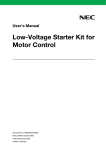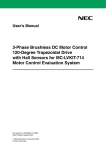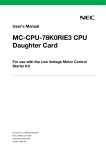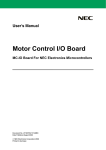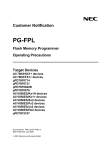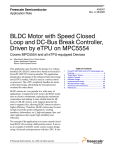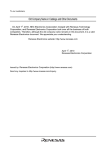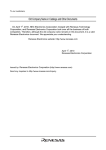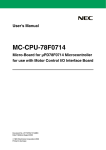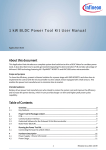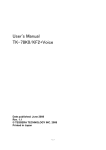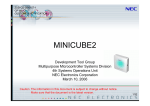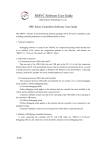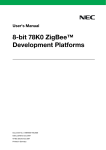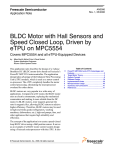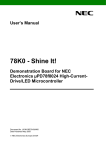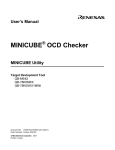Download Low-Voltage Starter Kit For Motor Control User`s Manual
Transcript
User’s Manual Low-Voltage Starter Kit For Motor Control Document No. U18220EE1V0UM00 Date Published June 2006 © NEC Electronics Corporation 2006 Printed in Germany CAUTION This is a Test- and Measurement equipment with possibility to be significantly altered by user through hardware enhancements/modifications and/or test or application software. Thus, with respect to Council Directive 89/336/EEC (Directive on compliance with the EMC protection requirements), this equipment has no autonomous function. Consequently this equipment is not marked by the CE-symbol. EEDT-ST-0005-10 Redemption of Waste Electrical and Electronic Equipment (WEEE) in accordance with legal regulations applicable in the European Union only: This equipment (including all accessories) is not intended for household use. After use the equipment cannot be disposed of as household waste. NEC Electronics (Europe) GmbH offers to take back the equipment. All you need to do is register at www.eu.necel.com/weee. All (other) product, brand, or trade names used in this pamphlet are the trademarks or registered trademarks of their respective owners. Product specifications are subject to change without notice. To ensure that you have the latest product data, please contact your local NEC Electronics sales office. 2 User’s Manual U18220EE1V0UM00 NOTES FOR CMOS DEVICES 1 VOLTAGE APPLICATION WAVEFORM AT INPUT PIN Waveform distortion due to input noise or a reflected wave may cause malfunction. If the input of the CMOS device stays in the area between VIL (MAX) and VIH (MIN) due to noise, etc., the device may malfunction. Take care to prevent chattering noise from entering the device when the input level is fixed, and also in the transition period when the input level passes through the area between VIL (MAX) and VIH (MIN). 2 HANDLING OF UNUSED INPUT PINS Unconnected CMOS device inputs can be cause of malfunction. If an input pin is unconnected, it is possible that an internal input level may be generated due to noise, etc., causing malfunction. CMOS devices behave differently than Bipolar or NMOS devices. Input levels of CMOS devices must be fixed high or low by using pull-up or pull-down circuitry. Each unused pin should be connected to VDD or GND via a resistor if there is a possibility that it will be an output pin. All handling related to unused pins must be judged separately for each device and according to related specifications governing the device. 3 PRECAUTION AGAINST ESD A strong electric field, when exposed to a MOS device, can cause destruction of the gate oxide and ultimately degrade the device operation. Steps must be taken to stop generation of static electricity as much as possible, and quickly dissipate it when it has occurred. Environmental control must be adequate. When it is dry, a humidifier should be used. It is recommended to avoid using insulators that easily build up static electricity. Semiconductor devices must be stored and transported in an anti-static container, static shielding bag or conductive material. All test and measurement tools including work benches and floors should be grounded. The operator should be grounded using a wrist strap. Semiconductor devices must not be touched with bare hands. Similar precautions need to be taken for PW boards with mounted semiconductor devices. 4 STATUS BEFORE INITIALIZATION Power-on does not necessarily define the initial status of a MOS device. Immediately after the power source is turned ON, devices with reset functions have not yet been initialized. Hence, power-on does not guarantee output pin levels, I/O settings or contents of registers. A device is not initialized until the reset signal is received. A reset operation must be executed immediately after power-on for devices with reset functions. 5 POWER ON/OFF SEQUENCE In the case of a device that uses different power supplies for the internal operation and external interface, as a rule, switch on the external power supply after switching on the internal power supply. When switching the power supply off, as a rule, switch off the external power supply and then the internal power supply. Use of the reverse power on/off sequences may result in the application of an overvoltage to the internal elements of the device, causing malfunction and degradation of internal elements due to the passage of an abnormal current. The correct power on/off sequence must be judged separately for each device and according to related specifications governing the device. 6 INPUT OF SIGNAL DURING POWER OFF STATE Do not input signals or an I/O pull-up power supply while the device is not powered. The current injection that results from input of such a signal or I/O pull-up power supply may cause malfunction and the abnormal current that passes in the device at this time may cause degradation of internal elements. Input of signals during the power off state must be judged separately for each device and according to related specifications governing the device. User’s Manual U18220EE1V0UM00 3 • The information in this document is current as of June, 2006. The information is subject to change without notice. For actual design-in, refer to the latest publications of NEC Electronics data sheets or data books, etc., for the most up-to-date specifications of NEC Electronics products. Not all products and/or types are available in every country. Please check with an NEC Electronics sales representative for availability and additional information. • No part of this document may be copied or reproduced in any form or by any means without the prior written consent of NEC Electronics. NEC Electronics assumes no responsibility for any errors that may appear in this document. • NEC Electronics does not assume any liability for infringement of patents, copyrights or other intellectual property rights of third parties by or arising from the use of NEC Electronics products listed in this document or any other liability arising from the use of such products. No license, express, implied or otherwise, is granted under any patents, copyrights or other intellectual property rights of NEC Electronics or others. • Descriptions of circuits, software and other related information in this document are provided for illustrative purposes in semiconductor product operation and application examples. The incorporation of these circuits, software and information in the design of a customer's equipment shall be done under the full responsibility of the customer. NEC Electronics assumes no responsibility for any losses incurred by customers or third parties arising from the use of these circuits, software and information. • While NEC Electronics endeavors to enhance the quality, reliability and safety of NEC Electronics products, customers agree and acknowledge that the possibility of defects thereof cannot be eliminated entirely. To minimize risks of damage to property or injury (including death) to persons arising from defects in NEC Electronics products, customers must incorporate sufficient safety measures in their design, such as redundancy, fire-containment and anti-failure features. • NEC Electronics products are classified into the following three quality grades: "Standard", "Special" and "Specific". The "Specific" quality grade applies only to NEC Electronics products developed based on a customerdesignated "quality assurance program" for a specific application. The recommended applications of an NEC Electronics product depend on its quality grade, as indicated below. Customers must check the quality grade of each NEC Electronics product before using it in a particular application. "Standard": Computers, office equipment, communications equipment, test and measurement equipment, audio and visual equipment, home electronic appliances, machine tools, personal electronic equipment and industrial robots. "Special": Transportation equipment (automobiles, trains, ships, etc.), traffic control systems, anti-disaster systems, anti-crime systems, safety equipment and medical equipment (not specifically designed for life support). "Specific": Aircraft, aerospace equipment, submersible repeaters, nuclear reactor control systems, life support systems and medical equipment for life support, etc. The quality grade of NEC Electronics products is "Standard" unless otherwise expressly specified in NEC Electronics data sheets or data books, etc. If customers wish to use NEC Electronics products in applications not intended by NEC Electronics, they must contact an NEC Electronics sales representative in advance to determine NEC Electronics' willingness to support a given application. (Note) (1) "NEC Electronics" as used in this statement means NEC Electronics Corporation and also includes its majority-owned subsidiaries. (2) "NEC Electronics products" means any product developed or manufactured by or for NEC Electronics (as defined above). M8E 02. 11-1 4 User’s Manual U18220EE1V0UM00 For further information, please contact: NEC Electronics Corporation 1753, Shimonumabe, Nakahara-ku, Kawasaki, Kanagawa 211-8668, Japan Tel: 044-435-5111 http://www.necel.com/ [America] [Europe] [Asia & Oceania] NEC Electronics America, Inc. 2880 Scott Blvd. Santa Clara, CA 95050-2554, U.S.A. Tel: 408-588-6000 800-366-9782 http://www.am.necel.com/ NEC Electronics (Europe) GmbH Arcadiastrasse 10 40472 Düsseldorf, Germany Tel: 0211-65030 http://www.eu.necel.com/ NEC Electronics (China) Co., Ltd 7th Floor, Quantum Plaza, No. 27 ZhiChunLu Haidian District, Beijing 100083, P.R.China TEL: 010-8235-1155 http://www.cn.necel.com/ Hanover Office Podbielski Strasse 166 B 30177 Hanover Tel: 0 511 33 40 2-0 NEC Electronics Shanghai Ltd. Room 2509-2510, Bank of China Tower, 200 Yincheng Road Central, Pudong New Area, Shanghai P.R. China P.C:200120 Tel: 021-5888-5400 http://www.cn.necel.com/ Munich Office Werner-Eckert-Strasse 9 81829 München Tel: 0 89 92 10 03-0 Stuttgart Office Industriestrasse 3 70565 Stuttgart Tel: 0 711 99 01 0-0 United Kingdom Branch Cygnus House, Sunrise Parkway Linford Wood, Milton Keynes MK14 6NP, U.K. Tel: 01908-691-133 Succursale Française 9, rue Paul Dautier, B.P. 52180 78142 Velizy-Villacoublay Cédex France Tel: 01-3067-5800 Sucursal en España Juan Esplandiu, 15 28007 Madrid, Spain Tel: 091-504-2787 NEC Electronics Hong Kong Ltd. 12/F., Cityplaza 4, 12 Taikoo Wan Road, Hong Kong Tel: 2886-9318 http://www.hk.necel.com/ Seoul Branch 11F., Samik Lavied’or Bldg., 720-2, Yeoksam-Dong, Kangnam-Ku, Seoul, 135-080, Korea Tel: 02-558-3737 NEC Electronics Taiwan Ltd. 7F, No. 363 Fu Shing North Road Taipei, Taiwan, R. O. C. Tel: 02-8175-9600 NEC Electronics Singapore Pte. Ltd. 238A Thomson Road, #12-08 Novena Square, Singapore 307684 Tel: 6253-8311 http://www.sg.necel.com/ Tyskland Filial Täby Centrum Entrance S (7th floor) 18322 Täby, Sweden Tel: 08 638 72 00 Filiale Italiana Via Fabio Filzi, 25/A 20124 Milano, Italy Tel: 02-667541 Branch The Netherlands Steijgerweg 6 5616 HS Eindhoven The Netherlands Tel: 040 265 40 10 G06.6-1A User’s Manual U18220EE1V0UM00 5 [MEMO] 6 User’s Manual U18220EE1V0UM00 Preface Readers This manual is intended for users who want to understand the functions of the low voltage starter kit for motor control. Purpose This manual presents the hardware manual of the low voltage starter kit for motor control. Organization This system specification describes the following sections: Legend • Kit Contents • Hardware Setup • Standalone Operation • Drive and Motor Protection • Software Setup • Software Installation • Using the NEC Electronics C Compiler and Source Code Debugger • Download and Debug the Code • GUI Operation Symbols and notation are used as follows: Weight in data notation : Left is high-order column, right is low order column Active low notation : xxx (pin or signal name is over-scored) or /xxx (slash before signal name) Memory map address: : High order at high stage and low order at low stage Note : Explanation of (Note) in the text Caution : Item deserving extra attention Remark : Supplementary explanation to the text Numeric notation : Binary... XXXX or XXXB Decimal... XXXX Hexadecimal... XXXXH or 0x XXXX Prefixes representing powers of 2 (address space, memory capacity) K (kilo): 210 = 1024 M (mega): 220 = 10242 = 1,048,576 G (giga): 230 = 10243 = 1,073,741,824 User’s Manual U18220EE1V0UM00 7 [MEMO] 8 User’s Manual U18220EE1V0UM00 Table of Contents Preface . . . . . . . . . . . . . . . . . . . . . . . . . . . . . . . . . . . . . . . . . . . . . . . . . . . . . . . 7 Chapter 1 Introduction. . . . . . . . . . . . . . . . . . . . . . . . . . . . . . . . . . . . . . . . . . . . . . . . . . . 15 Chapter 2 Kit Contents . . . . . . . . . . . . . . . . . . . . . . . . . . . . . . . . . . . . . . . . . . . . . . . . . . 16 Chapter 3 Hardware Setup . . . . . . . . . . . . . . . . . . . . . . . . . . . . . . . . . . . . . . . . . . . . . . . 17 Chapter 4 Standalone Operation . . . . . . . . . . . . . . . . . . . . . . . . . . . . . . . . . . . . . . . . . . 20 Chapter 5 Drive and Motor Protection . . . . . . . . . . . . . . . . . . . . . . . . . . . . . . . . . . . . . . 21 Chapter 6 Software Setup . . . . . . . . . . . . . . . . . . . . . . . . . . . . . . . . . . . . . . . . . . . . . . . . 22 Chapter 7 Software Installation . . . . . . . . . . . . . . . . . . . . . . . . . . . . . . . . . . . . . . . . . . . 23 Chapter 8 Using the NEC Electronics C Compiler and Source Code Debugger . . . . 24 Chapter 9 Download and Debug the Code . . . . . . . . . . . . . . . . . . . . . . . . . . . . . . . . . . 27 Chapter 10 GUI Operation . . . . . . . . . . . . . . . . . . . . . . . . . . . . . . . . . . . . . . . . . . . . . . . . . 28 User’s Manual U18220EE1V0UM00 9 10 User’s Manual U18220EE1V0UM00 List of Figures Figure 1-1: Figure 3-1: Figure 3-2: Figure 3-3: Figure 3-4: Figure 3-5: Figure 7-1: Figure 7-2: Figure 8-1: Figure 8-2: Figure 8-3: Figure 8-4: Figure 8-5: Figure 9-1: Figure 10-1: Figure 10-2: Figure 10-3: Figure 10-4: Figure 10-5: Motor Control Starter Kit.............................................................................................. 15 MC-LV-KIT-714 Boards Stacked Up ........................................................................... 17 Motor Phase Connections ........................................................................................... 18 Hall Sensor Connections ............................................................................................. 18 Standalone Operation ................................................................................................. 19 Speed Display ............................................................................................................. 19 Motor Control Software and Documents Installation GUI............................................ 23 Software Installation Window ...................................................................................... 23 Jumpers for Standalone Operation ............................................................................. 24 Debugging Setup......................................................................................................... 24 Debugging Environment Shown with QB-78K0MINI On-Chip Debugger .................... 25 PM Plus Workspace .................................................................................................... 26 PM Plus Window ......................................................................................................... 26 Source Code in Debugging Window ........................................................................... 27 Compiler Options for PC GUI Operation ..................................................................... 28 PC COM Port Selection............................................................................................... 28 BLDCM GUI ................................................................................................................ 29 Launching PID Parameter Window ............................................................................. 29 PID Parameter Window ............................................................................................... 29 User’s Manual U18220EE1V0UM00 11 12 User’s Manual U18220EE1V0UM00 List of Tables Table 3-1: Motor Connections ......................................................................................................... 17 User’s Manual U18220EE1V0UM00 13 14 User’s Manual U18220EE1V0UM00 Chapter 1 Introduction The low-voltage starter kit for motor control (MC-LVKIT-714) is a complete 3-phase motor control evaluation system for NEC Electronics’ microcontroller-type, application-specific standard products (ASSPs) for motor control. The kit contains all necessary hardware and software to quickly set up and run a low-voltage brushless DC motor (BLDCM). Figure 1-1: Motor Control Starter Kit User’s Manual U18220EE1V0UM00 15 Chapter 2 Kit Contents • MC-78F0714 micro-board containing the µPD78F0714 microcontroller • MC-I/O board that interfaces between the micro-board and the power module • Low-voltage power module (MC-PWR-LV) containing the power MOSFETs • Pittman N2311 12V BLDC motor • FW7362/15 DC power supply • Sample software for a BLDC-Hall-714-LV 120-degree trapezoidal drive For information about the electrical characteristics and hardware functions of the µPD78F0714 microcontroller, refer to µPD78F0714 Preliminary User’s Manual (U16928E). For the instruction descriptions, refer to the 78K/0 Series Instruction User’s Manual (U12326E). 16 User’s Manual U18220EE1V0UM00 Chapter 3 Hardware Setup The kit can be purchased as one unit with all three boards connected as shown below: Figure 3-1: MC-LV-KIT-714 Boards Stacked Up To attach the motor, connect the phase U, V and W terminals to the J3 connector block on the MC-PWR-LV power board and the Hall sensor terminals to the J5 connector block on the MC-IO control board. Table 3-1: Pittman N2311 Motor Terminals Motor Connections MC-IO MV-PWR-LV Phase U - Beige — J3 - 1 Phase V - Red — J3 - 2 Phase W - Orange — J3 - 3 Hall sensor 1 - Gray J5–13 — Hall sensor 2 - Blue J5–14 — Hall sensor 3 - White J5–7 — Hall sensor 5VDC - Purple J5–6 — Hall sensor GND - Black J5–5 — Motor terminal connections are shown in Figures 3-2 and 3-3. User’s Manual U18220EE1V0UM00 17 Chapter 3 Hardware Setup Figure 3-2: Motor Phase Connections Figure 3-3: Hall Sensor Connections The software to run the motor is programmed into the microcontroller’s flash memory. After the motor is connected, the program is ready to run the motor as soon as the 15 VDC power supply is plugged into J6 of the MC-IO board. When the kit is powered up or reset, the LED displays “SELF”, indicating that the kit is in standalone mode and you can use the push buttons and potentiometer on the MC-IO board to control the motor. 18 User’s Manual U18220EE1V0UM00 Chapter 3 Hardware Setup To control the motor from a GUI on your PC, connect a serial cable to the J9 RS-232 port on the MC-IO board and rebuild the code with the GUI macro option as described later in this manual. Figure 3-4: Standalone Operation Three seconds after power up, the LED displays the current set speed. Figure 3-5: Speed Display User’s Manual U18220EE1V0UM00 19 Chapter 4 Standalone Operation After power up in standalone mode, the motor can be operated as follows: <1> Press the START/STOP button to run the motor. <2> Turn the potentiometer clockwise to accelerate or counterclockwise to decelerate. <3> Wait for the LED to display the actual motor speed calculated from the Hall sensor interrupts. <4> Press the FORWARD or REVERSE button to change the rotation direction. <5> Press the MODE button to display the set speed. <6> Press START/STOP to stop the motor. Note: If the potentiometer position is set to higher speeds, and the motor rotation is suddenly reversed, an error condition may occur due to a time-out or over-current detection and the motor will stop operating. To reboot, press the RESET switch on the MC-IO board, adjust the potentiometer to a lower speed and restart. 20 User’s Manual U18220EE1V0UM00 Chapter 5 Drive and Motor Protection The starter kit and the motor are protected against unexpected events such as overload, motor stall and malfunction of the Hall sensors. If such faults are detected, the motor stops rotating and the fault condition is displayed on the seven-segment LED. For details on the protection functions implemented in hardware, consult the user’s manual for MC-PWR-LV low-voltage power module. The sample code software also has built-in fault detection algorithms as an extra measure of protection. Consult the software manual for details. In standalone (SELF) mode, the LED displays the following fault conditions: • Motor over-current: “O – C – “ • Motor stall fault: “– – – –“ • Hall sensor fault: “H A L L“ In PC (GUI) mode, the LED displays “PC” all the time and the GUI will displays all fault conditions. Refer to section Chapter 10 ”GUI Operation” on page 28 for more information. User’s Manual U18220EE1V0UM00 21 Chapter 6 Software Setup The software CD-ROM bundled with the kit contains PDF versions of this document, the user manuals and electrical schematics for all hardware module components, and the entire sample project program for the NEC Electronics 78K0 firmware-based development tools environment. The software sample code is supplied in source format and can be modified as needed. The following sections describe NEC Electronics America’s development tools environment, how to install it on your computer, and how to rebuild and download executable code to the microcontroller’s flash memory. Before proceeding with the tools installation, however, refer to all of the documentation on the CD-ROM for detailed information about the starter kit and the sample software. 22 User’s Manual U18220EE1V0UM00 Chapter 7 Software Installation <1> Insert the CD-ROM supplied with your MC-LVKIT-714 starter kit. <2> The CD-ROM should initialize automatically. If it doesn’t, click Start → Run. Browse to your CD-ROM drive and select Motol_Control.exe. <3> Select MC-LVKIT-714 from the drop down list. Figure 7-1: Motor Control Software and Documents Installation GUI <4> Install all of the software in the following recommended sequence: • NEC Electronics C compiler and assembler software • MC-LVKIT-714 software Figure 7-2: Software Installation Window User’s Manual U18220EE1V0UM00 23 Chapter 8 Using the NEC Electronics C Compiler and Source Code Debugger To set up the MC-LVKIT-714 starter kit for debugging, follow the steps below. <1> Disconnect the M-78F0714 micro board by separating it from the MC-IO board. <2> Remove jumpers JP5 2-5, JP5 3-6 and 2JP7 1-2 and reconnect M-78F0714 to MC-IO board. Figure 8-1: Jumpers for Standalone Operation Figure 8-2: 24 Debugging Setup User’s Manual U18220EE1V0UM00 Chapter 8 Using the NEC Electronics C Compiler and Source Code Debugger <3> Attach the on-chip debugging emulator’s target connector to 2JP7 on the M-78F0714 and the USB cable to your computer as shown bellow. Figure 8-3: Debugging Environment Shown with QB-78K0MINI On-Chip Debugger Note: The on-chip debugger has a 5 MHz internal clock source by default. The MC-78F0714 must be operated at 20 MHz. Use the external 20 MHz oscillator supplied with the kit. Consult the on-chip debugger user’s manual for information about how to attach the external oscillator. The sample program “BLDC-Hall-714-LV 120-degree Trapezoidal Drive” is installed in step (b) of the “Install Software” section in \Motor_Control\BLDC_Hall_714 folder. The sample code includes a workspace and project files used with Project Manager Plus, which is NEC Electronics’ integrated development environment software. To recompile and debug the sample program follow the steps below: <1> Run PM Plus program installed by the NEC Electronics assembler software. <2> Launch PM Plus from Start →Programs →NEC Tools32. <3> PM Plus will display its main window as shown below. User’s Manual U18220EE1V0UM00 25 Chapter 8 Using the NEC Electronics C Compiler and Source Code Debugger Figure 8-4: PM Plus Workspace <4> Click File and select Open Workspace. <5> Browse to C:\NECTools32\ \Motor_Control\BLDC_Hall_714 and select BLDC_LV.prw PM Plus workspace file. <6> The newly loaded workspace file will contain one project called LV_BLDC_Hall-714.prj as shown below. Figure 8-5: PM Plus Window <7> To recompile the code, click Build and select Rebuild. <8> At this point, you may change the code and recompile as needed. <9> After building the code successfully, you may download and run or debug the code using an on-chip debugging emulator. 26 User’s Manual U18220EE1V0UM00 Chapter 9 Download and Debug the Code <1> To debug the code, select Debug from Build menu or click the Debug button on the tool bar. By default the code automatically will be downloaded to the microcontroller’s flash memory through the on-chip debugging emulator and the source code displayed in the Debugger window as shown below. Figure 9-1: Source Code in Debugging Window <2> Use the RUN command to execute code in debugging mode. At this point, the motor can be controlled from the user interface in standalone mode or GUI mode. <3> Stop execution using the STOP button. <4> For details on how to use the debugger, consult the ID78K0-QB User’s Manual. User’s Manual U18220EE1V0UM00 27 Chapter 10 GUI Operation To operate the motor from the PC GUI, the code has to be rebuilt with “GUI” option. Select Compiler Options from PM+ Tool menu and type “GUI” in Preprocessor →Define Macro entry. Figure 10-1: Compiler Options for PC GUI Operation Rebuild and download the code to the microcontroller flash. At this point the motor can be controlled from the GUI only. Connect the PC serial port to the starter kit J9 DB-9 RS232 connector with the serial cable supplied and launch the communication program Motor Panel, click Start →Programs →NEC Tools32 →Motor Panel GUI. <1> Select the appropriate COM port your PC and click OK. Figure 10-2: 28 PC COM Port Selection User’s Manual U18220EE1V0UM00 Chapter 10 GUI Operation The GUI will launch if the connection is established: Figure 10-3: BLDCM GUI <2> To operate the motor, use the controls in the GUI. <3> To change the PID parameters click on the tuning key symbol Figure 10-4: Launching PID Parameter Window The tuning window will allow the changing of P, I or D constants: Figure 10-5: PID Parameter Window The new parameter values will be updated in the internal RAM when the motor is restarted again. To make the changes permanent, the user has to update #define values in on KP_DEF, KI_DEF and KD_DEF in control.h header file and rebuild the code. User’s Manual U18220EE1V0UM00 29 [MEMO] 30 User’s Manual U18220EE1V0UM00
































